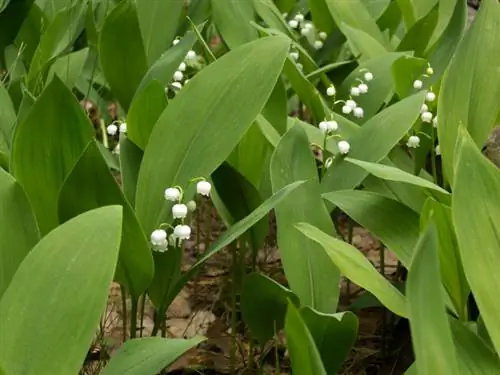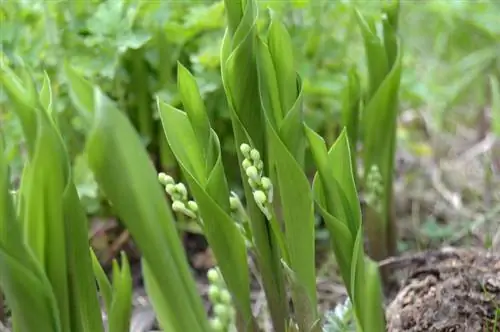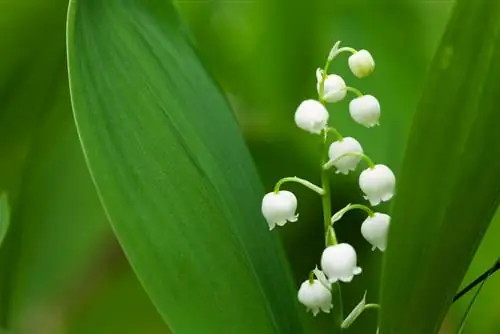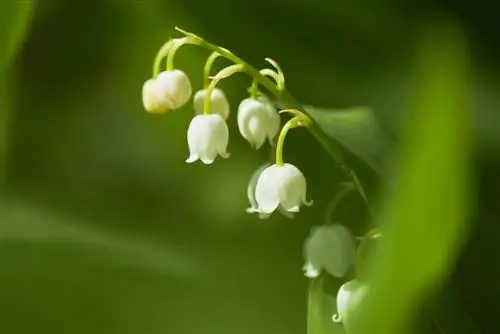- Author admin [email protected].
- Public 2023-12-16 16:46.
- Last modified 2025-01-23 11:20.
Lily of the valley is one of the easiest spring bloomers to care for and will enchant any garden. They place hardly any demands on the soil and location. However, the flowers are highly poisonous and should therefore not be planted in gardens where there are small children and pets.
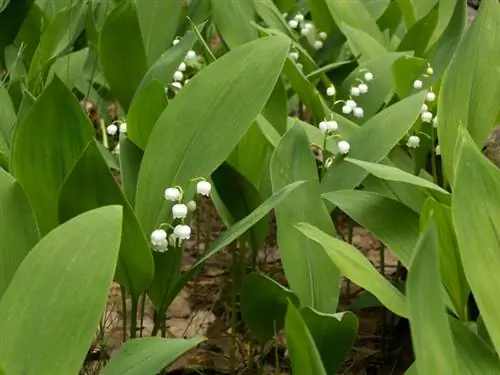
Where and how should you plant lily of the valley?
Lily of the valley is best planted in shady to partially shaded locations in slightly moist, nutritious soil. The ideal planting time is in autumn or spring, and maintain a planting distance of 20 centimeters.
Which location is suitable for lily of the valley?
Lily of the valley prefers shade or partial shade. The blazing midday sun should be avoided.
What should the substrate be like?
A slightly moist, nutritious soil is ideal. Before planting the rhizomes (€12.00 on Amazon), improve it with compost.
When is the best time to plant?
It is best to plant lily of the valley in autumn or spring.
What planting distance is ideal?
When planting, maintain a planting distance of 20 centimeters. If the lily of the valley is to be grown as a ground cover, a distance of 10 centimeters is sufficient.
Do lilies of the valley need a root barrier?
Lilies of the valley tend to spread widely via their rhizomes. It is therefore advisable to create a rhizome barrier.
Can lilies of the valley be grown in pots?
You can grow lilies of the valley in pots from March and plant them outside in May. You can then enjoy the flowering earlier.
How to plant lilies of the valley?
Dig a planting hole about ten centimeters deep. When planting the rhizomes, make sure that they are placed in the hole the right way up. The eye must always be directed upwards.
How long is the flowering period?
Depending on the weather, the flowering period begins at the end of April and can last until the beginning of June. The main flowering time is in May.
How are lilies of the valley propagated?
Sowing is possible. When growing in pots, the seeds must first be stratified, i.e. go through a cold phase.
Dividing rhizomes makes more sense. The plant will then bloom earlier.
Lily of the valley also reproduces itself via rhizomes and the seeds that ripen in the red berries.
Can you transplant lily of the valley?
In principle, lilies of the valley can be transplanted. However, you have to get the roots completely out of the ground, otherwise they will sprout again.
It is easier to propagate the spring flower by dividing the rhizomes and placing the plants immediately in the new location.
Which neighbors do lilies of the valley get along with?
- Rhododendrons
- Azaleas
- Tulips
- Easter bells
- Grape Hyacinths
Lily of the valley is said to have a positive effect on the growth of shrubs.
Are lilies of the valley poisonous?
Lilies of the valley are highly poisonous, in all parts of the plant. Occasionally there is confusion with the herb wild garlic because the leaves grow at the same time and look very similar. If the leaves give off a garlic-like smell, it is non-toxic wild garlic.
Tip
In some European countries, lilies of the valley are protected and may not be picked or dug up. In Germany, picking small bouquets is allowed, but digging up the rhizomes is forbidden almost everywhere.

